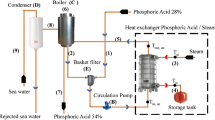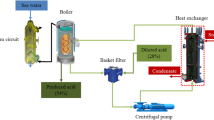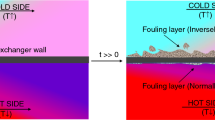Abstract
Super saturation of inversely soluble salts in the phosphoric acid concentration process, like calcium sulfate, promotes fouling on the heat exchanger walls. This phenomenon leads to reduce the efficiency of such equipment and their continuous operation and increase energy losses. The present work aimed at studying the effect of the deposit of calcium sulfate on the fouling resistance on a heated walls. The fouling resistance was determined based on the operating data collected from the phosphoric acid concentration loop of a cross flow heat exchanger. X-ray diffraction analysis method was used to determine the crystal form of calcium sulfate. In addition, this paper aimed at modeling the fouling resistance with experimental data under various operating conditions using response surface methodology (RSM) in order to studying the interactive effects of operating parameters on fouling. Results show that the anhydrite (CaSO4) is the main crystal form of fouling formed on heat exchanger walls indicating that the crystallization fouling dominates the fouling process. The volume flow affects the fouling resistance especially at high wall temperature by increasing the fouling resistance with decreasing volume flow. The fluid temperatures are found to enhance significantly the fouling resistance on the surface. The determination coefficient of the proposed RSM model in the studied case was found to be 99.54%, which is considered to be satisfactory.











Similar content being viewed by others
Abbreviations
- A:
-
Heat transfer area; m2
- Cp:
-
Specific heat capacity; J/kg.K
- F:
-
Corrective factor for the average logarithmic temperature difference (= 1 pure Counter Flow Arrangement); -
- g:
-
Gravity acceleration; m/s2
- HMT:
-
Total head of the pump; m
- ṁ:
-
Mass flow rate; kg /h
- P:
-
Pressure; bar
- Q:
-
Heat flow; W
- Rf:
-
Fouling resistance; m2.K/W
- T:
-
Temperature; °C or K
- t:
-
Time; h
- U:
-
Global heat transfer coefficient; W/m2.K
- ύ:
-
Volume flow rate; m3/h
- ρ:
-
Density; kg/m3
- in:
-
Input of the heat exchanger
- ml:
-
Logarithmic mean
- out:
-
Output of the heat exchanger
References
Jradi R, Fguiri A, Marvillet C, Jeday MR (2019) Tubular heat exchanger fouling in phosphoric acid concentration process. Heat Exchangers. Intechopen edition; 1–16. https://doi.org/10.5772/intechopen.88936
Jradi R, Marvillet C, Jeday MR (2022) Fouling in industrial heat exchangers: Formation, detection and mitigation. Heat Transfer. Intechopen edition. https://doi.org/10.5772/intechopen.102487
Adams JF (2004) Gypsum scale formation and control during continuous sulphuric acid neutralization. University of Toronto: Ph.D. thesis. https://hdl.handle.net/1807/111726
Behbahani RM, Muller-Steinhagen H, Jamialahmadi M (2003) Heat exchanger fouling in phosphoric acid evaporators - evaluation of field data-. In: Proc. ECI Conf. Heat exchanger fouling and cleaning:fundamentals and applications. Mexique, Santa Fé. https://dc.engconfintl.org/heatexchanger/9/
Mwaba MG, Rindt CCM, Van Steenhoven AA (2006) Experimental investigation of CASO4 crystallization on a flate plate. Heat Transfer Eng 27:42–54
Berce J, Zupančič M, Može M, Golobič I (2021) A review of crystallization fouling in heat exchangers. Processes 9:1356–1379
Pääkkönen TM, Riihimäki M, Simonson CJ, Muurinen E, Keiski RL (2012) Crystallization fouling of CaCO3-Analysis of experimental thermal reistance and its uncertainty. Int J Heat Mass Transf 55:6927–6937
Al-Gailani A, Charpentier T, Sanni O, Neville A (2022) Crystallization fouling in domestic appliances and systems. Heat Transfer Eng 43:1301–1310
Sheikholeslami R, Watkinson AP (2010) Composite fouling, fundamentals and mechanisms. Phys Chem Biol Asp Water 1:270–280
Sheikholeslami R (2000) Calcium sulfate fouling –precipitation or particulate: A proposed composite model. Heat Transfer Eng 21:24–33
Jradi R, Marvillet C, Jeday MR (2020) Modeling and comparative study of heat exchangers fouling in phosphoric acid concentration plant using experimental data. J Heat Mass Transf 56:2653–2666. https://doi.org/10.1007/s00231-020-02888-9
Kim B, Choi Y, Choi J, Shin Y, Lee S (2020) Effect of susfactant on wetting due to fouling in membrane distillation membrane: Application of response surface methodology (RSM) and artificial neural networks (ANN). Korean J Chem Eng 37:1–10
Jang H, Park SJ, Kim J (2022) Response surface methodology to investigate the effects of operational parameters on membrane fouling and organic matter rejection in hard-shell encased hollow fiber membrane. Chemosphere 287:132132. https://doi.org/10.1016/j.chemosphere.2021.132132
Lavanya M, Rao P, Murthy VR, Selvaraj S (2020) Parametric study of aluminium alloy fouling in marine environment using RSM technique. Tribol Mater Surfaces Interfaces 14:110–118. https://doi.org/10.1080/17515831.2019.1690406
Jradi R, Marvillet C, Jeday MR (2022) Artificial neural networks and response surface methodology for prediction of cross-flow heat exchanger fouling in phosphoric acid concentration plant. Int J Mech Energy 9:25–30
Jradi R, Fguiri A, Marvillet C, Jeday MR (2019) Experimental analysis of heat transfer coefficients in phosphoric acid concentration process. J Stat Mech Theory Exp 2019(8):15. https://doi.org/10.1088/1742-5468/ab2531
Jradi R, Marvillet C, Jeday MR (2022) Application of an artificial neural networks method for the prediction of the tube-side fouling resistance in a shell-and-tube heat exchanger. Fluid Dyn Mater Process 18:1511–1519. https://doi.org/10.32604/fdmp.2022.021925
Speight JG (2015) Fouling treatment and control. Fouling in refineries, 1st edn. Elsevier Inc. Gulf Professional Publishing, pp 453–473. https://doi.org/10.1016/C2013-0-19044-7
Alizadeh M, Ganji DD (2020) Multi-objective optimization of an externally finned two-phase closed thermosyphon using response surface methodology. Appl Therm Eng 171:115008
Jradi R, Marvillet C, Jeday MR (2022) Estimation of cross-flow heat exchanger fouling in phosphoric acid concentration plant using artificial neural networks. Int J Mech Energy 9:8–12
Mohd Zaid MH, Matori KA, Abdul Aziz SH, Kamari HM, Mat Yunus WM, Wahab AA, Samsudin NF (2016) Fabrication and crystallization of ZnO-SLS glass derived willemite glass-cerramics as a potential material for optics applications. J Spectrosc 2016:1–7
Lv X, Xiang L (2022) The generation process, impurity removal and high value utilzation of phosphogysum material. Nanomaterials 12:3021
Xu J, Zhao JD, Jia Y, Li T, Yang SB, Zhang ZH (2021) Effect of fouling resistance in heat exchanger and the crystal form of CaCo3 in hard circulating cooling water with electrostatic field and alternating current electric field. Water Sci Technol 84:1608–1622
Alqahtani AS, Alenazy WM, Pandiaraj S (2020) Optimization on heat transfer coefficient of plate heat exchanger using MWCNT-TiO2 nanofluid by response surface methodology. Mater Res Express 7:084002
Jradi R, Marvillet C, Jeday MR (2022) Analysis and estimation of cross-flow heat exchanger fouling in phosphoric acid concentration plant using response surface methodology (RSM) and artificial neural network (ANN). Sci Rep 12:20437. https://doi.org/10.1038/s41598-022-24689-2
Author information
Authors and Affiliations
Corresponding author
Additional information
Publisher's note
Springer Nature remains neutral with regard to jurisdictional claims in published maps and institutional affiliations.
Rights and permissions
Springer Nature or its licensor (e.g. a society or other partner) holds exclusive rights to this article under a publishing agreement with the author(s) or other rightsholder(s); author self-archiving of the accepted manuscript version of this article is solely governed by the terms of such publishing agreement and applicable law.
About this article
Cite this article
Jradi, R., Marvillet, C. & Jeday, M.R. Parametric study of calcium sulfate crystallization fouling in cross-flow heat exchanger using response surface methodology. Heat Mass Transfer 59, 1971–1985 (2023). https://doi.org/10.1007/s00231-023-03368-6
Received:
Accepted:
Published:
Issue Date:
DOI: https://doi.org/10.1007/s00231-023-03368-6




